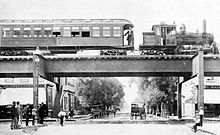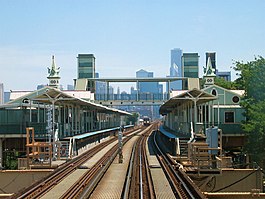|
Lake Street Elevated Railroad
The Lake Street Elevated Railroad was the second permanent elevated rapid transit line to be constructed in Chicago, Illinois. The first section of the line opened in November 1893.[2] Its route is still used today as part of the Green Line route of the Chicago "L" system. History The Lake Street Elevated Railway Company was chartered on February 7, 1888, and granted a 25-year franchise by the city council to build an elevated railroad above Lake Street from Canal Street to the city limits.[3] It was originally planned that the line would use a steam-powered monorail system that had been developed by Joe Meigs in Cambridge, Massachusetts, however the company eventually chose to use more traditional steam locomotives.[2] Construction of the line began in 1889. Potential investors found the franchise too restrictive[2] and a new 40 year franchise was awarded by the city council in November 1890, that allowed the railroad to extend to Market Street in downtown Chicago. By 1892 the company had debts of $17 million (equivalent to $576 million in 2023[4]).[citation needed] It was sold to new owners,[2] renamed the Lake Street Elevated Railroad Company, and a new charter was granted on August 24, 1892.[3] The first section, running from the downtown terminal at Market Street and Madison to California Avenue opened to the public in October 1893. The line was completed to 52nd Avenue (Laramie)—a total length of 6.4 miles (10.3 km)—in April 1894.[1] Service was extended to Austin Avenue in (what was then) the suburb of Austin via a section of track built at-grade in April 1899.[5] References
External links |
||||||||||||||||||||||||||||||
